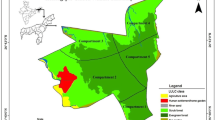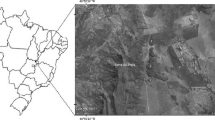Abstract
We have compared edible plant richness, diversity and differential patterns of use in two Mapuche communities of Argentina. The populations of Rams and Cayulef are located in a herbaceous steppe, far from the temperate forests of northwestern Patagonia where their ancestors lived in the past. Ecological concepts and methods, such as diversity indices, niche breadth and optimal foraging theory have been used in this comparative study. Our results indicate that the diversity of wild plants used in Rams and Cayulef is associated with the variety of gathering environments they visit. When comparing diversity indices among the three environments within each community, in Cayulef we found the highest diversity indices for steppe species and the lowest for forest plants. In contrast, in Rams the niche breadth is similar in all environments, indicating an ample exploration and use of edible wild plants. Cost and benefit trade-offs seem to be considered in both communities when edible plants are collected. Nevertheless, we found that the people from Rams not only utilize a greater richness of wild plants than the Cayulef people, but also use more nutritious resources, spend more time traveling to the gathering sites and a longer handling time in preparing these edible plants. This study has quantitatively shown that the restricted access to Pehuen forest (Araucaria araucana) is the main factor which seems to limit wild plant diversity used in these Mapuche communities.
Similar content being viewed by others
References
Aagesen D.L. 1998. Indigenous resource rights and conservation of the monkey-puzzle tree (Araucaria araucana, Araucariaceae): a case study from southern Chile. Economic Botany 52: 146–160.
Agresti A. 1996. An Introduction to Categorical Data Analysis. John Wiley & Sons, Inc., New York.
Alcorn J.B. 1995. The scope and aims of ethnobotany in a developing world. In: Schultes R.E. and von Reis S. (eds), Ethnobotany: Evolution of a Discipline. Dioscorides Press, Portland, Oregon, pp. 23–39.
Barros V., Cordon V., Moyano C., Mendez R., Forguera J. and Pizzio O. 1983. Cartas de precipitación de la zona oeste de las provincias de Río Negro y Neuquén. Primera contribución. Universidad Nacional del Comahue, Facultad de Ciencias Agrarias, Cinco Saltos, Argentina.
Begossi A. 1996. Use of ecological methods in ethnobotany: diversity indices. Economic Botany 50: 280–289.
Begossi A. and Richerson P.J. 1992. The animal diet of families from Buzios Island (Brazil): an optimal foraging approach. Journal of Human Ecology 3: 433–458.
Begossi A. and Richerson P.J. 1993. Biodiversity, family income and ecological niche: a study on the consumption of animal foods on Buzios Island (Brazil). Ecology of Food and Nutrition 30: 30–51.
Benz B.F., Ceballos J., Muñoz E. and Santana F. 1996. Ethnobotany serving society: a case study from the Sierra de Manantlán Biosphere Reserve. Sida 17: 1–16.
Benz B.F., Cevallos J., Santana F., Rosales J. and Graf S.M. 2000. Losing knowledge about plant use in the Sierra de Manantlan Biosphere Reserve, Mexico. Economic Botany 54: 183–191.
Betzig L. 1997. Human Nature. A Critical Reader. Oxford University Press, New York.
Brown K. 1994. Approaches to valuing plant medicines: the economics of culture or the culture of economics? Biodiversity and Conservation 3: 734–750.
Cabrera A.L. 1976. Regiones fitogeográficas argentinas. Fac. 1. Enciclopedia Arg. de la Agricultura y Jardinería. Tomo II. Editorial Acme S.A.C.I., Buenos Aires, Argentina.
Caniago I. and Siebert S.F. 1998. Medicinal plant ecology, knowledge, and conservation in Kalimantan, Indonesia. Economic Botany 52: 229–250.
Conover W.J. 1971. Practical Nonparametric Statistics. John Wiley & Sons, New York.
Correa M.N. 1969-1998. Flora Patagónica. Partes 1, 2, 3, 4, 5 y 7. Colección Científica del Instituto Nacional de Tecnología Agropecuaria, Buenos Aires, Argentina.
Cruz Cruz J. 1991. Alimentación y Cultura. Antropología de la conducta alimentaria. Ediciones Universidad de Navarra, Pamplona, Spain.
Díaz-Betancourt M., Ghermandi L., Ladio A., López-Moreno I.R., Raffaele E. and Rapoport E.H. 1999. Weeds as a source for human consumption. A comparison between tropical and temperate Latin America. Revista de Biologia Tropical 47: 329–338.
Duke J.A. 1985. Handbook of Medicinal Herbs. CRC Press, Boca Raton, Florida.
Elias T.S. and Dykeman P.A. 1990. Edible Wild Plants. A North American Field Guide. Sterling Publishing Co., New York.
Gerritsen P.R.W. 1998. Community development, natural resource management and biodiversity con-servation in the Sierra de Manantlán biosphere reserve, Mexico. Community Development Journal 33: 314–324.
Golluscio R.A., Deregibus V.A. and Paruelo J.M. 1998. Sustainability and range management in the Patagonian steppes. Ecología Austral 8: 265–284.
Gragson T.L. 1993. Human foraging in lowland South America: patterns and process of resource procurement. Research in Economic Anthropology 14: 107–138.
Hanazaki N., Tamashiro J.Y., Leitao-Filho H.F. and Begossi A. 2000. Diversity of plant uses in two Caicara communities from the Atlantic Forest coast, Brazil. Biodiversity and Conservation 9: 597–615.
Hardesty D.L. 1975. The niche concept: suggestions for its use in human ecology. Human Ecology 3: 71–85.
Hawkes K., O'Connell J.F. and Rogers L. 1997. The behavioral ecology of modern hunter-gatherers, and human evolution. Trends in Ecology and Evolution 12: 29–31.
Höft M., Barik S.K. and Lykke A.M. 1999. Quantitative ethnobotany. Applications of multivariate and statistical analyses in ethnobotany. People and Plants Working Paper 6. Unesco, Paris.
Houghton P.J. and Manby J. 1985. Medicinal plants of the Mapuche. Journal of Ethnopharmacology 13: 89–103.
Juliano M.D. 1996. Los Mapuches, la más larga resistencia. Anuario del Instituto de Estudios Histórico-Sociales 11 (Tandil, Argentina): 303–327.
Kacelnik A. and Krebs J.R. 1997. Yanomamö dreams and starling payloads: the logic of optimatility. In: Betzig L. (ed.), Human Nature. A Critical Reader. Oxford University Press, New York, pp. 21–35.
Ladio A. and Lozada M. 2000a. Edible wild plant use in a Mapuche community of Northwestern Patagonia. Human Ecology 28: 53–71.
Ladio A. and Lozada M. 2000b. Uso de productos no maderables en los bosques templados del NO de la Patagonia: la recolección de plantas silvestres comestibles. In: Ojeda I.C. and Meza S.A. (eds), Proceedings VI Inter-American Enviromental Congress and IV Seminar on the Environment and Sustainable Development. Sic. Editorial Ltda, Santander, Colombia, pp. 32–38.
Mac Arthur R.H. and Pianka E.R. 1966. On optimal use of a patchy environment. American Naturalist 100: 603–609.
Magurran A. 1988. Ecological Diversity and its Measurement. Croom-Helm Limited, London. Marticorena C. and Quezada M. 1985. Flora vascular de Chile. Guyana 42: 1–157.
Mösbach E.W. 1992. Botánica Indígena de Chile. Museo Chileno de Arte Precolombino. Fundación Andes. Ed. Andrés Bello, Santiago, Chile.
Pimentel D., McNair M., Buck L., Pimentel M. and Kamil J. 1997. The value of forest to world food security. Human Ecology 25: 91–115.
Prance G.T. and Plana V. 1998. The use of alien plants in tropical South American folk medicines. In: Prendergast H.D.V., Etkin N.L., Harris D.R. and Houghton P.J. (eds), Plants for Food and Medicine. Royal Botanic Gardens, Kew, UK, pp. 185–200.
Schmidt-Hebbel H. and Pennachiotti Monti I. 1985. Tabla de Composición Química de Alimentos Chilenos. Fac. Ccias. Químicas y Farmacéuticas, Universidad de Chile, Editorial Universitaria, Santiago, Chile.
Smith E.A. 1983. Antropological applications of optimal foraging theory: A critical review. Current Anthropology 24: 625–651.
Smith-Ramírez C. 1996. Algunos usos indígenas-tradicionales de la flora del bosque templado. In: Armesto J., Villagrán C. and Arroyo M.K. (eds), Ecología de los bosques nativos de Chile. Editorial Univesitaria, Santiago, Chile, pp. 389–404.
Somnasang P. and Moreno-Black G. 2000. Knowing, gathering and eating: knowledge and attitudes about wild food in an Isan village in NE Thailand. Journal of Ethnobiology 20: 197–216.
Stephens D.W. and Krebs J.R. 1986. Foraging Theory. Princeton University Press, Princeton, New Jersey.
Wetterstrom W. 1978. Cognitive systems, food patterns, and paleoethnobotany. In: Ford R.I. (ed.), The Nature and Status of Ethnobotany. Anthropological Paper 69, Museum of Anthropology. University of Michigan, Ann Arbor, Michigan, pp. 81–95.
Wickramasinghe A., Pérez M.R. and Blockhus J.M. 1996. Non-timber forest product gathering in Ritigala Forest (Sri Lanka): household strategies and community differentiation. Human Ecology 24: 493–519.
Rights and permissions
About this article
Cite this article
Ladio, A.H., Lozada, M. Comparison of wild edible plant diversity and foraging strategies in two aboriginal communities of northwestern Patagonia. Biodiversity and Conservation 12, 937–951 (2003). https://doi.org/10.1023/A:1022873725432
Issue Date:
DOI: https://doi.org/10.1023/A:1022873725432




